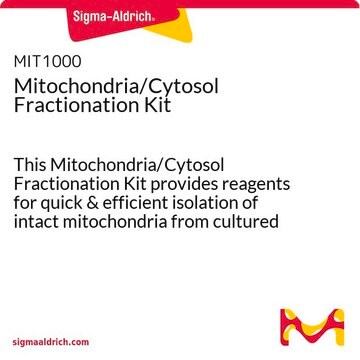MITOISO1
Mitochondria Isolation Kit
sufficient for 10-20 g (animal tissue), sufficient for 50 assays (2 mL), isolation of enriched mitochondrial fraction from animal tissues
Synonym(s):
Mitochondria Purification Kit
About This Item
Recommended Products
Quality Level
usage
sufficient for 10-20 g (animal tissue)
sufficient for 50 assays (2 mL)
shelf life
2 yr
technique(s)
fractionation: suitable
shipped in
dry ice
storage temp.
−20°C
Looking for similar products? Visit Product Comparison Guide
Application
- for the separation of mitochondrial and cytosolic fraction for determining the branched-chain aminotransferase (BCAT) activity
- for the isolation of mitochondria from glomeruli and heart
- for the isolation of mitochondria from injured brain samples for the measurement of mitochondrial transmembrane potential
Features and Benefits
- Specially formulated extraction reagents & proven procedure suitable for small scale isolation - Isolate an enriched, intact mitochodrial fraction in a microfuge tube.
- Produces functionally active, intact mitochondria - Resulting mitochondria are suitable for in vitro assays for apoptosis, oxidative stress or other studies.
- Includes stain & protocol for determining inner membrane integrity - Determine the integrity of the inner mitochondrial membrane without the need to purchase other reagents.
- Compatible with the Cytochrome c Oxidase Assay Kit - Allows easy determination of the integrity of the outer mitochondrial membrane
Kit Components Also Available Separately
- T9201Trypsin from bovine pancreas, powder, ≥7,500 BAEE units/mg solidSDS
related product
signalword
Danger
hcodes
Hazard Classifications
Eye Irrit. 2 - Resp. Sens. 1 - Skin Irrit. 2 - STOT SE 3
target_organs
Respiratory system
Storage Class
10 - Combustible liquids
Certificates of Analysis (COA)
Search for Certificates of Analysis (COA) by entering the products Lot/Batch Number. Lot and Batch Numbers can be found on a product’s label following the words ‘Lot’ or ‘Batch’.
Already Own This Product?
Find documentation for the products that you have recently purchased in the Document Library.
Customers Also Viewed
Articles
Centrifugation separates organelles based on size, shape, and density, facilitating subcellular fractionation across various samples.
Cellular apoptosis assays to detect programmed cell death using Annexin V, Caspase and TUNEL DNA fragmentation assays.
Cellular oxidative stress is countered by enzymatic scavengers and antioxidant modulators against reactive oxygen species damage.
Our team of scientists has experience in all areas of research including Life Science, Material Science, Chemical Synthesis, Chromatography, Analytical and many others.
Contact Technical Service












